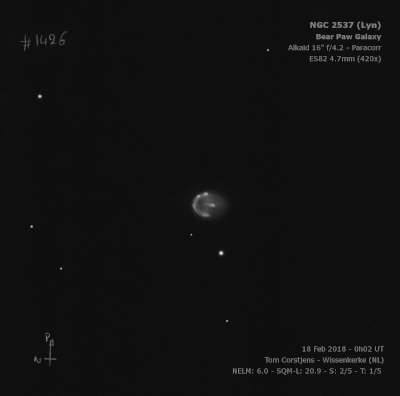Bear Claw Nebula,Bear-Paw Galaxy
Bear Claw Nebula,Bear-Paw Galaxy

William Herschel discovered NGC 2537 = H IV-55 = h491 on 6 Feb 1788 (sweep 809) and recorded "pB; R; pL; preceding a star about 1'." On 10 Mar 1788 (sweep 817) he logged "pB, R, almost of an even light througout, approaching to a planetary [he placed it in the category of planetary nebulae] but very ill defined, and a little fainter on the edges, about 3/4 or 1' dia." John Herschel observed the galaxy on 19 Mar 1828 (sweep 139) and remarked, "It is a globular cluster. Being a remarkable fine night, I see the stars." NGC 2537 was observed 20 times at Birr Castle and even noted as "probably spiral" in Jan 1852, although photographs show no significant spirality. Other observations refer to its resolvability and the GC and NGC description call it a globular cluster! When it was photographed at Lick Observatory with the Crossley reflector, Curtis noted (1918), "This is not a cluster, as described in the NGC, but a bright, irregular spiral." Francis Peases desribed it as a "horseshoe" based on a photograph with the 60" at Mt. Wilson, and mentions a "faint spot" nearby to the east, which is the companion galaxy NGC 2537A.
Wolfgang Steinicke reports that the nickname is from Ron Buta, based on an observation through a 36" telescope at McDonald 36" (Webb Society Galaxy Handbook, 1981): "Small and of relatively high surface brightness; shaped like a bear-paw, the structure consisting of a single spiral arm winding from W to E around the N side; this ring-tail includes 3 knots, one of about 15 mag; a bar-like feature shows in the interior region of the arm and extends to the S edge of the galaxy; there is a faint glow between the arm and the bar feature".
300/350mm - 13.1" (2/25/84): fairly faint, small, round, no structure.
400/500mm - 17.5" (3/23/85): moderately bright, fairly small, round. The "Bear-paw" galaxy has an unusual appearance with a dark lane or vacuity in the center. A small slightly brighter knot is visible along the NW edge. A mag 11 star is 2' SE. Located 6.5' E of mag 8.4 SAO 42225. IC 2233, a faint edge-on, lies 18' SE.
900/1200mm - 48" (4/15/10): At 624x, the view of the highly irregular "Bear-paw" galaxy (Arp 6) was fascinating. The galaxy is fairly large, roundish, 1.5' diameter and is broken up into bright knots and arcs that border a large curving dust lane that winds through the glow and traces out a dark "U" inside the galaxy. The main bright regions form the three "toes" of the Bear-paw. On the NW side, the first "toe" consists of the brightest knot, ~0.3' diameter, with a second smaller and fainter knot close south. The combined glow for this "toe" is ~30" diameter. In the center is a brighter core, ~0.3' diameter, which is nearly isolated by the obscuring dust, but the glow extends to the south end of the galaxy where it brightens slightly at the rim, forming the middle toe. The third toe is on the following side of the galaxy (~0.3' diameter) and is less prominent, though slightly brighter due east of center. The curving "U"-shaped dust channel enters the galaxy both west and east of the middle toe in two parallel lanes and curves around the core, forming a noticeable arc on the north side of the core.
NGC 2537A, situated 4.5' E, appeared fairly faint, fairly small, round, weak central brightening. A mag 13.5 star lies 1.2' S and a mag 15.4 star is 57" WSW.
Notes by Steve Gottlieb